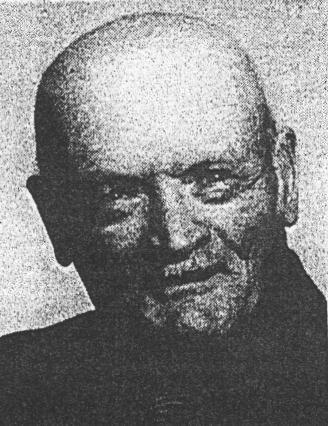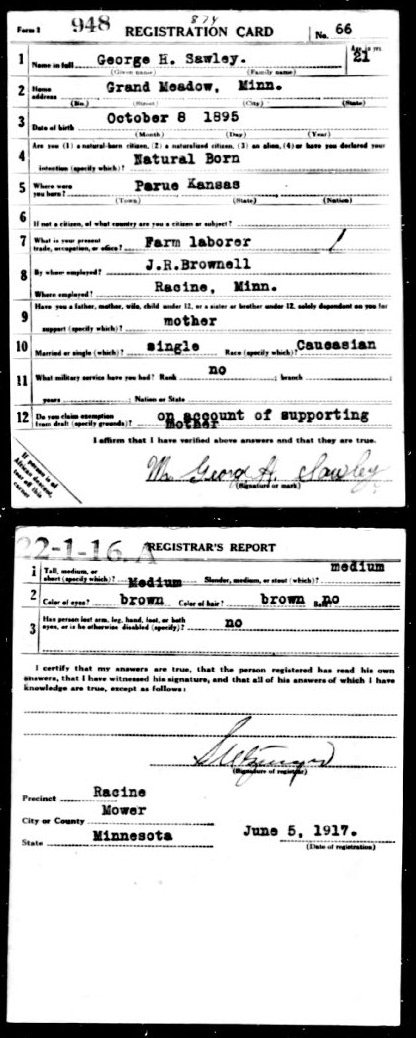
George H. Sawley
Wilmore, Comanche County, Kansas.


George H. Sawley
Wilmore, Comanche County, Kansas.
George H. Sawley was born Oct. 8, 1896 and passed away at the Veterans' Hospital Sept. 7, 1984.He was preceded in death by his parents and a brother and sister.
He lived with a German family for 15 years before he enlisted in the army and fought in Germany in World War I. He was injured during this time. Upon arrival in New York he was placed in the hospital there for more than a year.
George came to Wilmore about 50 years ago and lived alone and worked for his living.
His World War records were lost and he had no government help until recently. He attended the Baptist Church in Wilmore and was a member of Assembly of God Church in Coldwater.
"Shorty" loved music and could play the violin, guitar, and other instruments.
He moved from Wilmore to Valley Manor in Protection and later to Pioneer Lodge in Coldwater. He was happy there and was glad to visit his friends.
Faye Thurman officiated; Alice Smith sang a solo to the accompaniment of Fayette Blount. Interment was in the Wilmore Cemetery. Service was held Sept. 9, 1984 at the Hatfield-Prussia Funeral Home in Coldwater.
George H. Sawley was born in Western Kansas in 1897. His folks died when he was young and he was adopted by Mr. and Mrs. Lehman near Wautoma, Wisconsin. He grew up on their farm learning the German language and learning how to work hard on the farm. He enlisted in World War 1 and spent much time in Germany on the front lines. He was also an interpreter of the German language for the prisoners there.When he returned to the United States he spent a great deal of time in the hospitals recuperating from many wounds. He worked at many jobs in several states before coming to Wilmore where he has resided since.
Comanche County is his home and he has enjoyed his violin, yard work, and other hobbies.
Comanche County History, Vol. 1 (pp. 649 - 650)
STARK BROS. FAMOUS Undated advertisement reproduced in Comanche County History, Vol. 1 (pp. 649 - 650).
Stark Brothers and Luther Burbank Creations
is U.S. patented orchard and nursery stock.
Call: George H. Sawley
Stark Salesman
Box 174
Wilmore, Kansas.

GEORGE H. SAWLEY
U.S. ARMY
WORLD WAR I
October 8, 1896 - September 7, 1984

Draft Registration card: George H. Sawley of Grand Meadow, Minnesota.
United States, Selective Service System. World War I Selective Service System Draft Registration Cards, 1917-1918. Washington, D.C.: National Archives and Records Administration. M1509, 4,582 rolls.
by Jerry Ferrin
George Sawley's nickname was "Shorty" Sawley, and he disliked it intensely, to say the least.
I learned that the hard way at a young age when I cheerfully greeted him one day in Wilmore and called him "Shorty", as that was what people in the community, including my dad and grand-dad, generally called him when they referred to him. He became very angry at me.
After that, I noted that people called him "Shorty" when he wasn't present, but addressed him by his given name, George, when speaking to him.
I felt bad about inadvertently offending him, because I liked and admired him, especially because he played the violin.
I recall sitting with Richard Janson across the street from George's tiny house in Wilmore in the evening and hearing George play the violin for himself.
(His house still stands southwest and across the street from where the Wilmore Community Center is located today in 2005)
I didn't recognize the music he was playing as "folk music" such as "Turkey In the Straw", and suspect now that he was playing classical violin literature.
He was the first person I ever heard play the violin, as Richard and I listened from across the street in the darkness, and I thought he played beautifully. So far as I know, he didn't play at public events, just for himself.
George Sawley "wasn't quite right", as the local expression has it, and I was always told that it was because he had been gassed in World War I.
He was short in stature and a sort of odd man who went around mumbling to himself as I recall. He was also an inventive man.
For example, I recall that he invented something to trim grass around the base of picket fences, though I don't remember how it worked, or if it worked well, but, for all I know, it was an early version of "The Weedeater" device which uses a motor-driven rotating string to trim grass.
He was well-respected and well-liked in the community, despite the fact that he was a trifle "odd".
Looking back, I'm sure it is because people in the community were aware of his admirable record in WWI and that the reason he wasn't "quite right" was due to the injuries he had received in the service of our country.
Beyond that, he was quite an interesting person. I recall him as always talking fast and in an excited manner about his latest interest or invention.
This impression of him is indelibly associated in my mind with a conversation we had while standing in front of my great-grandmother's house in Wilmore, which had an iron picket fence at the time on the street side of the front lawn, and of him telling me he had invented something to trim the grass at the base of such fences.
He was a "colorful character" whose presence enriched the Wilmore community.
Thanks to Bobbi Huck for transcribing and contributing the above Comanche County History article to this web site!
Thanks to Shirley Brier for finding, transcribing and contributing the above obituary and photo to this web site!
This RootsWeb website is being created by HTML Guy Jerry Ferrin with the able assistance of many Contributors. Your comments, suggestions and contributions of historical information and photographs to this site are welcome. Please sign the Guest Book. This page was last updated 29 May 2007.